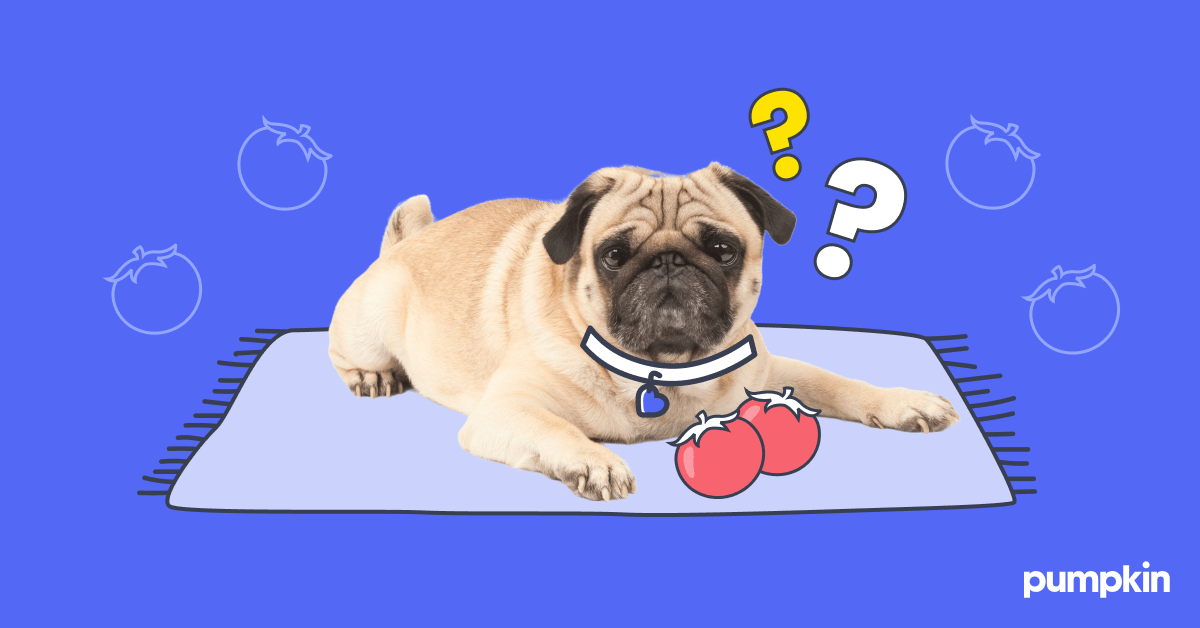Key Points:
- Yes, ripe tomatoes are safe for dogs.
- Dogs should avoid green tomatoes because they contain toxic compounds called solanine and tomatine.
- Too many tomatoes can cause stomach upset in dogs, so only share in moderation.
If you tend to have lots of tomatoes in your kitchen, you’ve probably shared a bite with your best friend before. After all, who can resist those sweet puppy-dog eyes staring at you while you’re prepping your famous tomato and peach Caprese salad?
Tomatoes are one of the most commonly eaten fruits in the United States. The average person consumes 19 pounds of tomatoes every year — but are they safe to share with your dog?
The quick answer: Yes, tomatoes are safe for your dog if they’re fully ripe. However, if they’re still green, we’re giving them the thumbs down. Green tomatoes are not safe for dogs to eat.
For our hungry pups’ sake, let’s dig a little deeper.
The facts about tomatoes and dogs
The tomato is from the Nightshade family, also known as the Solanaceae family, which also includes white potatoes, eggplant, and peppers.
The tomato plant’s green parts — its stem, leaves, roots, and unripe fruit — contain solanine and tomatine, which are toxic to humans and animals in high amounts.
As the tomato ripens, the toxins in the flesh decrease to minimal amounts, making them safe for your dog.
Signs of solanine and tomatine poisoning
If your dog gets into a tomato plant and eats the stem, leaves, roots, or an unripe tomato, look for signs of a bad reaction. If you notice any of the following symptoms, you should contact your vet:
- Vomiting
- Excessive drooling
- Difficulty breathing
- Dilated pupils
- Diarrhea
- Lethargy or drowsiness
- Rapid heart rate
- Muscle weakness
- Confusion
- Loss of appetite
- Loss of coordination
Fortunately, you don’t need to worry too much. Unless your dog has eaten a large amount of green tomatoes or a whole plant, they probably won’t suffer much more than diarrhea or vomiting. Still, it’s better to take precautions and block all tomato plants and green tomatoes from our sneaky snackers.
Nutritional value of tomatoes
If you offer your tail-wagger a ripe, red tomato chunk, there are many potential health benefits.
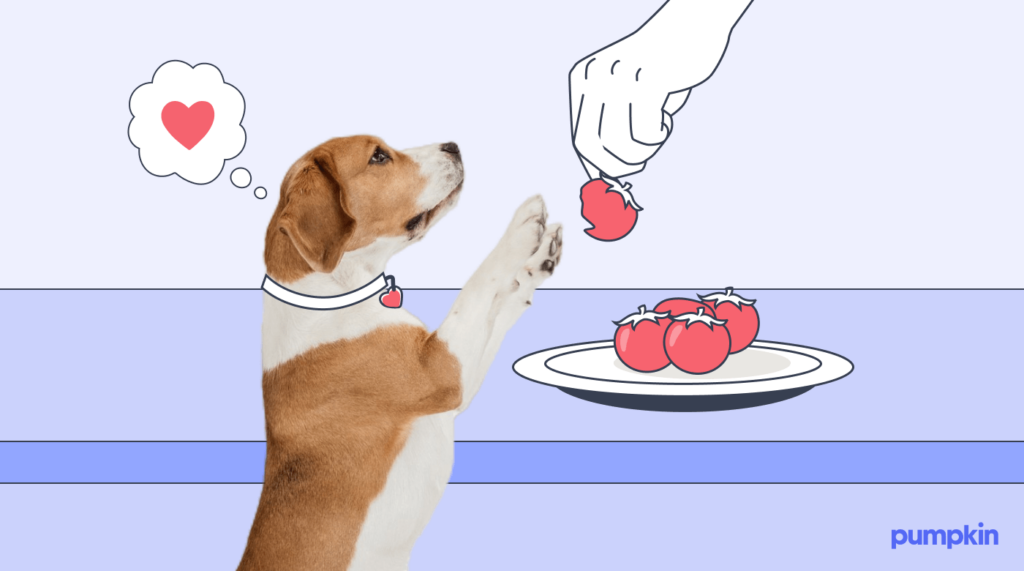
Tomatoes are low in calories and high in water, soluble fiber, and have an added nutrient punch of lycopene, beta-carotene, potassium, and vitamins A and C. Let’s see how these improve your dog’s health.
- Vitamin A: This nutrient promotes healthy vision and skin.
- Vitamin C: This vitamin supports the immune system by reducing inflammation, fighting some cancers, and supporting brain health.
- Lycopene: This antioxidant gives tomatoes their red color. It might also protect dogs from some types of cancer.
- Potassium: This mineral supports healthy kidney and heart function, promotes proper bone density, regulates fluid levels, and helps muscle development.
- Fiber: The fiber in tomatoes can help promote healthy bowel movements in your pet.
Pet Pro Tip: If you have a dog that is prone to ‘snacksidents’ – you should consider getting a dog insurance plan as soon as possible. It can help you afford the best care in the future by covering eligible vet bills for digestive illnesses, toxic ingestion, and more.
How to prepare tomatoes for dogs
If you pay attention to the color of the tomato (never green) and moderate the amount, an occasional tomato snack is a healthy treat that provides nutritional benefits for your dog.
When offering new foods, be sure to watch for allergic reactions and consult your veterinarian if they’ve been diagnosed with any diseases or food sensitivities. In the case of sugar-filled fruits, this is especially important if your dog has diabetes or weight problems.
Here are some guidelines for keeping your dog safe:
Offer tomatoes in moderation: For small dogs, a single cherry tomato or a slice of a larger tomato is sufficient. Larger dogs can have a couple of cherry tomatoes, but always keep treats to no more than 10% of their overall diet.
Remove seeds and stems: The seeds and green parts of the tomato plant contain solanine, which is toxic to dogs.
Cooking tomatoes: Cooking tomatoes can make them easier to digest and reduce the acidity, which might be gentler on your dog’s stomach. However, many common tomato-based sauces and meals are dangerous for our pups, so be careful. If your famous red sauce contains any onions or garlic (and we know it does), then it’s not dog-friendly.
If your dog has eaten the wrong part of a tomato or is having an adverse effect, call your vet.
The types of tomatoes to serve your pup

Here are some types of tomatoes that are safe for your canine companion:
Fresh tomatoes
You can feed your dog fresh red tomatoes in moderation.
Cooked tomatoes
Cooked and prepared tomatoes can also be safe, as long as they aren’t cooked with toxic ingredients like salt, vinegar, or garlic. For the same reason, don’t feed your dog tomato products with additives. It doesn’t matter if they’re stewed, boiled, or dried; just make sure they’re fully ripe, red tomatoes without added ingredients that will upset your dog’s stomach.
Canned tomatoes
Look for organic, ripe canned tomatoes with no added ingredients. Some canned products have added salts and sugars that aren’t healthy for your dog.
Grape and cherry tomatoes
These are healthy and safe for your pup. Your dog may choke if they gulp down whole treats, so it’s safer to cut them in half before you offer them.
Can puppies eat tomatoes?
Tomatoes don’t offer significant nutritional value for growing puppies and therefore shouldn’t be a regular part of their diet. However, there’s no harm in giving them tomatoes as an occasional treat.
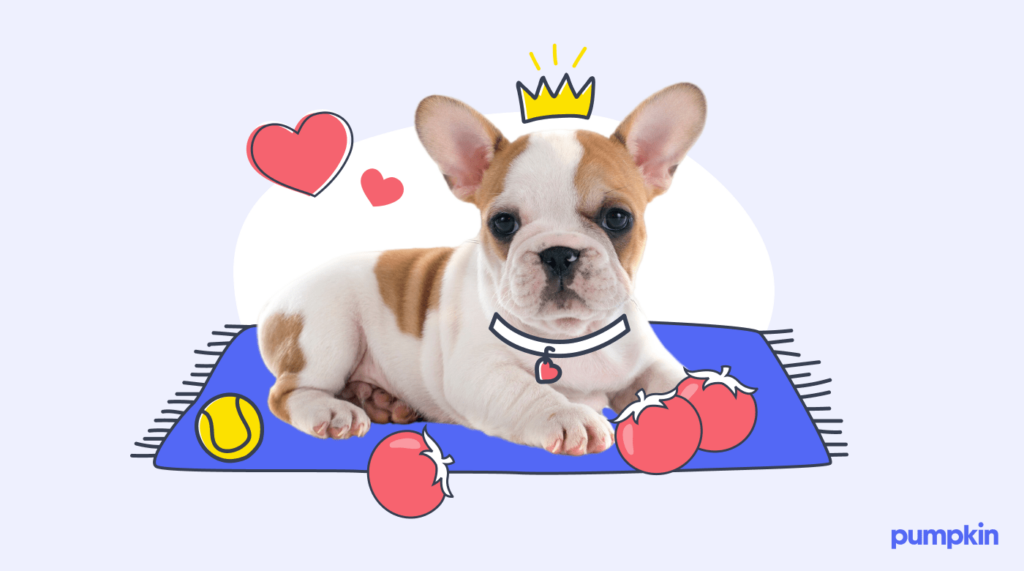
Cut the tomato into small pieces to aid digestion and avoid choking hazards. This also helps to control portion size more efficiently so you’re not accidentally overfeeding your puppy.
Can dogs have allergies to tomatoes?
Dogs can have an allergic reaction to fruits and vegetables, and tomatoes are no exception. Any time you’re offering your dog a new food, it’s best to go slow, start with small amounts, and watch for signs of allergic reactions:
- Diarrhea
- Itching
- Skin rash
- Stomach upset
- Vomiting
If any of these symptoms are present, stop offering tomatoes and talk to your vet.
Can dogs eat tomato ketchup and sauces?
Ketchup and tomato sauces can have many ingredients that are unhealthy for your dog, particularly salt and sugar.
Excessive salt intake can lead to dehydration, increased thirst, and in severe cases, sodium ion poisoning. Symptoms of salt poisoning include vomiting, diarrhea, tremors, elevated body temperature, and seizures.
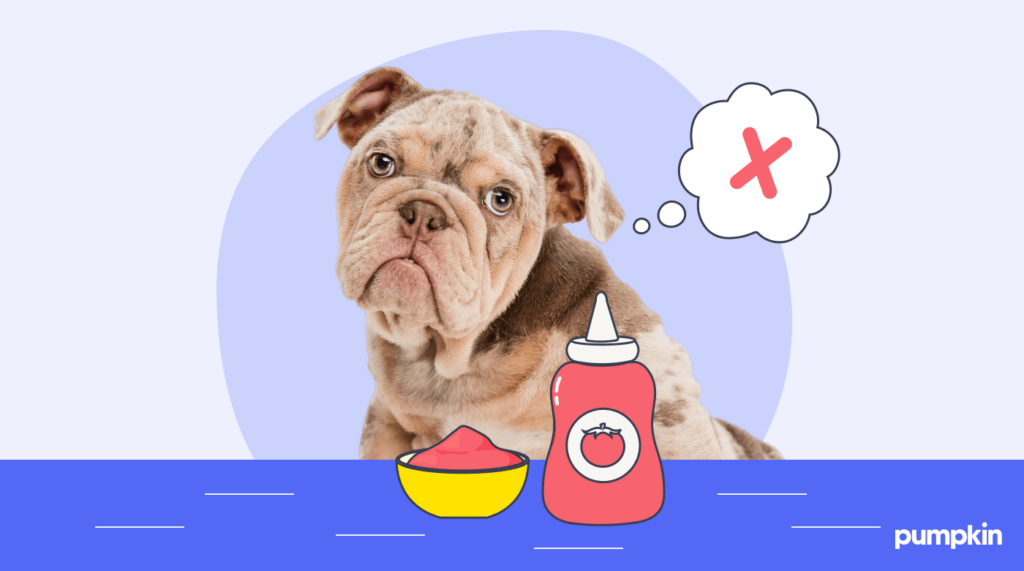
Sauces usually have high sugar content, which contributes to obesity, diabetes, and dental problems. Sugar-free varieties of ketchup and barbecue sauce may contain sweeteners like xylitol, which is extremely toxic to dogs. Garlic and onion powders, common in many ketchup and sauce recipes, are also highly toxic to dogs.
For these reasons, it’s best to avoid feeding your dog ketchup or tomato sauce. Always check ingredient labels for harmful additives and opt for natural, dog-safe foods instead.
Snack time: Ideas for DIY tomato dog treats
There are loads of recipes for dog treats involving tomatoes. For example, tomato sweet potato parmesan treats and cheesy tomato basil dog treats almost look good enough to try as an occasional snack yourself.
You can also try mixing up water, pureed ripe, red tomato, and some unsweetened gelatin. Pour the mixture into ice cube trays and freeze for a hydrating snack for your dog.
Or, try blending some blueberries or cranberries with plain yogurt along with some sliced grape tomatoes for a smoothie snack.
Tomatoes added to chopped or sliced green beans, pumpkin, or broccoli make a tasty and filling snack. The fiber will keep your pup satisfied without adding unnecessary calories.
Alternatives to tomatoes
If you are looking for healthy, dog-safe alternatives to tomatoes, here are some excellent vegetables and fruits that offer nutritional benefits and can be safely included in your dog’s diet:
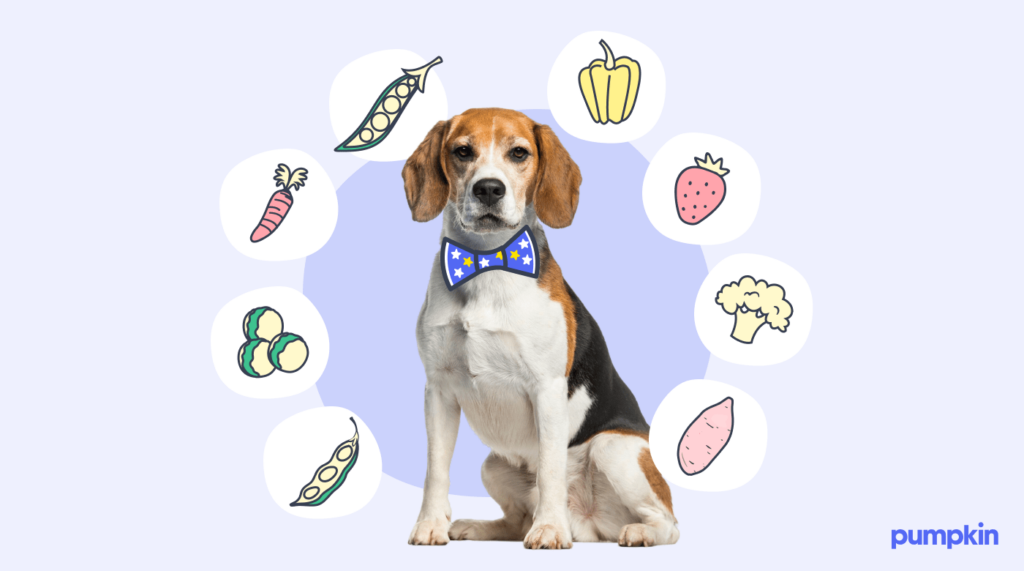
The verdict: Should you feed your dog tomatoes?
Red tomatoes can be fed to your dog, but make sure they only eat the ripe, fleshy part of the fruit.
Always consult a vet before making any changes to your dog’s diet and keep an eye on them when introducing new foods.
Want extra peace of mind as a pet parent? Learn more about Pumpkin pet insurance plans, which can reimburse you for qualifying vet bills in the future. Accidents can happen, and you always want to make sure your pet has the best possible care.
FAQs
- Wakshlag, J. J., & Balkman, C. E. (2010). Effects of lycopene on proliferation and death of canine osteosarcoma cells. American journal of veterinary research, 71(11), 1362–1370. https://doi.org/10.2460/ajvr.71.11.1362
- Schmid, Renee, DVM, DABVT, DABT et al. Xylitol poisoning in dogs. VCA Animal Hospitals. https://vcahospitals.com/know-your-pet/xylitol-toxicity-in-dogs
- Statista. Per capita consumption of fresh tomatoes in the United States from 2000 to 2022. (2024) https://www.statista.com/statistics/257302/per-capita-consumption-of-fresh-tomatoes-in-the-us/
- Vet Meds. https://vetmeds.org/pet-poison-control-list/salt/
- Canine Arthritis Resources and Education. Counting Calories: Low-and high-calorie treats for dogs. https://caninearthritis.org/article/calories-treats/
